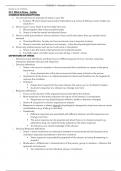Samenvatting
Summary of course 3.6 Occupational Health and Safety
- Instelling
- Erasmus Universiteit Rotterdam (EUR)
A summary of all the literature present in the course Occupational Health and Safety in the organizational psychology specialization (International Bachelor of Psychology). Does not include lecture notes
[Meer zien]




